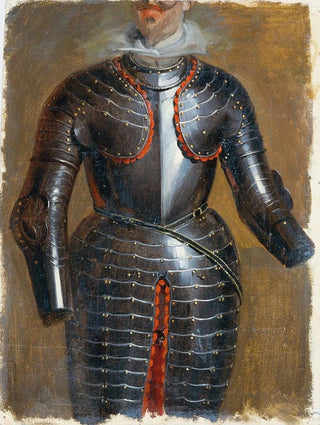Art print | Three-quarter armor - Johann Peter Krafft


View from behind

Frame (optional)
Reproduction Armure trois-quarts - Johann Peter Krafft – Introduction captivante
The artwork "Armure trois-quarts" by Johann Peter Krafft is part of an artistic tradition where the past and present converge, offering a captivating glimpse into European cultural heritage. This painting, which evokes grandeur and nobility, immerses us in an era when armor was not only a defensive element but also a symbol of status and power. The depiction of this armor, with its intricate details and shine, recalls tales of bravery and heroism, allowing viewers to imagine epic battles and valiant knights who have shaped history. By contemplating this piece, one feels a deep connection to stories of yore, an invitation to explore the intricacies of a bygone era.
Style and uniqueness of the work
Krafft's style is distinguished by meticulous attention to detail and a realistic approach. In "Armure trois-quarts," each element of the armor is rendered with precision that demonstrates the artist's technical mastery. The reflections of light on the metal, delicate ornaments, and varied textures combine to create a rich and dynamic composition. The use of shadows and highlights adds depth to the piece, making the armor almost alive, as if it could tell its own stories. This uniqueness also lies in how Krafft manages to capture the very essence of the object, endowing it with an almost spiritual dimension. The armor is not limited to its utilitarian function; it becomes a symbol of identity and the values of an era, reflecting human aspirations.
The artist and his influence
Johann Peter Krafft, a prolific artist of the 19th century, made his mark by blending art and history. Trained in the ateliers of the Académie des Beaux-Arts, he developed a style that combines classicism and romanticism, influencing many contemporary artists. His passion for history and interest in military and heroic subjects are evident in his works, among which "Armure trois-quarts" is a perfect example. Krafft succeeded in transcending the conventions of his time,

Matte finish

View from behind

Frame (optional)
Reproduction Armure trois-quarts - Johann Peter Krafft – Introduction captivante
The artwork "Armure trois-quarts" by Johann Peter Krafft is part of an artistic tradition where the past and present converge, offering a captivating glimpse into European cultural heritage. This painting, which evokes grandeur and nobility, immerses us in an era when armor was not only a defensive element but also a symbol of status and power. The depiction of this armor, with its intricate details and shine, recalls tales of bravery and heroism, allowing viewers to imagine epic battles and valiant knights who have shaped history. By contemplating this piece, one feels a deep connection to stories of yore, an invitation to explore the intricacies of a bygone era.
Style and uniqueness of the work
Krafft's style is distinguished by meticulous attention to detail and a realistic approach. In "Armure trois-quarts," each element of the armor is rendered with precision that demonstrates the artist's technical mastery. The reflections of light on the metal, delicate ornaments, and varied textures combine to create a rich and dynamic composition. The use of shadows and highlights adds depth to the piece, making the armor almost alive, as if it could tell its own stories. This uniqueness also lies in how Krafft manages to capture the very essence of the object, endowing it with an almost spiritual dimension. The armor is not limited to its utilitarian function; it becomes a symbol of identity and the values of an era, reflecting human aspirations.
The artist and his influence
Johann Peter Krafft, a prolific artist of the 19th century, made his mark by blending art and history. Trained in the ateliers of the Académie des Beaux-Arts, he developed a style that combines classicism and romanticism, influencing many contemporary artists. His passion for history and interest in military and heroic subjects are evident in his works, among which "Armure trois-quarts" is a perfect example. Krafft succeeded in transcending the conventions of his time,






